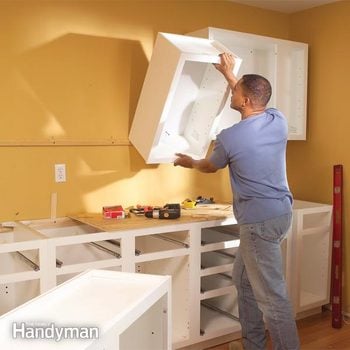To install base cabinets, measure and mark the height and position of the cabinets on the wall, then attach a ledger board to support the cabinets during installation. (19 words) If you’re planning a kitchen renovation or simply want to upgrade your current cabinets, installing base cabinets is an essential part of the process.
Whether you’re a DIY enthusiast or hiring professionals, properly installing base cabinets is crucial for a functional and aesthetically pleasing kitchen layout. By following some basic steps, you can ensure a successful installation and transform your kitchen space. We will guide you through the process of installing base cabinets, providing you with the necessary tips and insights to complete the task efficiently and effectively.
So let’s get started and create the kitchen of your dreams! (117 words)
Preparing For Installation
Before you begin installing base cabinets in your kitchen, it’s important to properly prepare for the process. This involves measuring and planning the layout, gathering all the necessary tools and materials, and clearing and preparing the work area. By taking these steps, you can ensure a smoother and more efficient installation. Let’s explore each step in detail.
Measuring and Planning the Layout
Accurate measurements and careful planning are the foundation of a successful cabinet installation. Measure the dimensions of your kitchen space, taking into account any obstacles such as water or gas pipes, electrical outlets, and windows. Determine the layout that best suits your needs, considering factors such as workflow, storage requirements, and aesthetic appeal. Sketch out a floor plan or use specialized software to visualize the placement of your base cabinets.
Gathering the Necessary Tools and Materials
To ensure a hassle-free installation, gather all the tools and materials you’ll need in advance. This will save you time and effort when you’re in the midst of the installation. Here’s a list of essentials:
- Power drill: for securing fasteners
- Tape measure: to ensure precise measurements
- Screwdriver: for adjusting screws and hinges
- Level: to ensure accurate alignment
- Shims: for leveling and stabilizing cabinets
- Stud finder: to locate wall studs for proper cabinet anchoring
- Pencil or marker: for marking measurements and stud locations
- Screws and mounting brackets: for attaching cabinets securely
- Cabinet screws: for joining and securing multiple cabinets together
- Wood glue: for reinforcing joints and enhancing stability
Clearing and Preparing the Work Area
Before installing your base cabinets, ensure that the work area is clear and conducive to a smooth installation process. Remove any obstacles, such as furniture or appliances, from the workspace. Clean the floor, walls, and surrounding areas to prevent dust or debris from interfering with the installation. Additionally, cover the floors with protective covering such as drop cloths or cardboard to prevent any accidental damage or scratches.
Installing Base Cabinets
Installing base cabinets is an essential step in creating a functional and organized kitchen or bathroom. These sturdy cabinets provide ample storage space and set the foundation for your countertop and appliances. In this blog post, we will guide you through the process of installing base cabinets, ensuring a professional and seamless finish.
Positioning and Leveling the First Cabinet
The first step in installing base cabinets is positioning and leveling the first cabinet. Proper alignment of the cabinets ensures a straight and even installation. Here’s how you can do it:
- Start by measuring the height and width of the space where the cabinets will be installed. Use these measurements to determine the positioning of the first cabinet.
- Mark the height of the base cabinet on the wall using a pencil. Use a level to ensure the horizontal line is straight.
- Place the first cabinet on the marked line, ensuring it is flush against the wall. Adjust the cabinet legs to level it, using a level to guide you.
- Secure the cabinet in place by screwing through the back panel into the wall studs. Make sure to use appropriate screws that are long enough to reach the studs.
Securing Cabinets Together
To ensure stability and a cohesive look, it is important to secure the base cabinets together. This step allows the cabinets to function as a single unit. Here’s what you need to do:
- Position the next cabinet adjacent to the first one, making sure they are flush and level. Use clamps to hold the cabinets together tightly.
- Drill pilot holes through the face frames of both cabinets, and then secure them together using screws. Make sure the screws are countersunk to achieve a seamless appearance.
- Repeat the process for each additional cabinet, ensuring they are aligned and securely attached to one another.
Securing Cabinets to the Wall
Securing the base cabinets to the wall adds stability and prevents any movement or sagging. Follow these steps to achieve a secure installation:
- Use a stud finder to locate the wall studs behind the cabinets.
- Mark the location of the studs on the back panel of each cabinet.
- Drill pilot holes through the marked locations, and then secure the cabinets to the wall using screws. Again, ensure the screws are long enough to reach the studs for a secure attachment.
Installing Cabinet Hardware
Once the base cabinets are installed and secured, it’s time to add the finishing touches with cabinet hardware. Here’s how you can do it:
- Decide on the placement of your hardware, such as handles or knobs, on the cabinet doors and drawers.
- Drill pilot holes for the hardware using a template or measuring carefully to ensure consistency.
- Attach the hardware using screws or bolts, tightening them securely.
Adjusting Cabinet Doors and Drawers
To achieve a polished and professional look, it’s important to adjust the cabinet doors and drawers to ensure they are level and aligned. Follow these steps to make any necessary adjustments:
- Check the alignment of the doors and drawers and adjust the hinges or slides as needed.
- Use a screwdriver to tighten or loosen the adjustment screws on the hinges or slides, depending on the direction and level of adjustment required.
- Test the doors and drawers by opening and closing them to ensure smooth operation.
- Make any necessary final adjustments to achieve the desired appearance and functionality.
By following these steps, you can install base cabinets effectively, ensuring a sturdy and visually appealing addition to your kitchen or bathroom. Remember to take your time during the installation process, paying attention to detail and accuracy for a professional outcome.
Finishing Touches
Finishing Touches Once you have successfully installed your base cabinets, it’s time to add the finishing touches to complete your kitchen renovation project. These final steps will not only enhance the overall appearance of your cabinets but also ensure their functionality and durability in the long run. In this section, we will walk you through the essential tasks that need to be done after installing the base cabinets, including applying caulk and fillers, installing countertops, connecting plumbing and electrical fixtures, and cleaning and inspecting the completed installation.Applying Caulk and Fillers
After securing the base cabinets in place, you will need to apply caulk and fillers to achieve a seamless and professional look. Caulk is used to fill any gaps between the cabinets and the walls or countertops, preventing moisture and debris from getting trapped. Start by carefully cleaning the gaps to ensure proper adhesion of the caulk. Then, using a caulk gun, apply a thin, even line of caulk along the joints. Smooth it out with your finger or a caulk finishing tool for a neat finish. For larger gaps or imperfections, use a filler to create a smooth surface before painting or applying a finish.Installing Countertops
Installing the countertops is the next step in completing your base cabinet installation. Whether you opt for granite, quartz, or laminate, the process involves precise measurements, cutting, and securing the countertops in place. First, measure the dimensions of your cabinets accurately, ensuring a perfect fit. Then, using a circular saw or a specialized cutting tool, carefully cut the countertops to size. Once the countertops are cut, carefully place them on the base cabinets and secure them using screws or adhesive. It’s crucial to ensure that the countertops are level and properly aligned to achieve a polished and functional kitchen workspace.Connecting Plumbing and Electrical Fixtures
To make your base cabinets fully functional, you’ll need to connect plumbing and electrical fixtures. If you’re installing a sink, whether it’s a drop-in, undermount, or farmhouse style, connect the plumbing lines to the appropriate valves and drains. Make sure to use plumber’s tape or sealant to prevent any leaks. For electrical fixtures such as outlets, switches, or under-cabinet lighting, consult a licensed electrician to ensure safe and proper installation. Remember to switch off the power supply before any electrical work and follow local building codes and regulations.Cleaning and Inspecting the Completed Installation
Once all the finishing touches are in place, it’s time to clean and inspect your completed cabinet installation. Remove any dust, debris, or construction residues from the cabinets, countertops, and surrounding areas. Wipe down the surfaces with a mild cleanser and a soft cloth to achieve a clean and polished finish. Inspect the cabinets, drawers, and hardware for any loose screws, hinges, or other issues that may need attention. Addressing these issues early on will prevent further damage and ensure the longevity of your newly installed base cabinets. In conclusion, the finishing touches are crucial in achieving a professional and polished look for your base cabinet installation. By applying caulk and fillers, installing countertops, connecting plumbing and electrical fixtures, and thoroughly cleaning and inspecting the completed installation, you’ll be able to enjoy a functional and beautiful kitchen for years to come. So take your time, follow the steps carefully, and enjoy the satisfaction of a job well done.
Credit: www.familyhandyman.com
Frequently Asked Questions On How To Install Base Cabinets
Can I Install Base Cabinets Myself?
Yes, you can install base cabinets yourself. Just make sure to follow the installation instructions, use the necessary tools, and have the required skills. It’s a DIY project that you can do with proper planning and precision. Happy cabinet installation!
Do Base Cabinets Need To Be Screwed To Floor?
Base cabinets should be screwed to the floor for stability and to prevent tipping. Attaching them ensures they remain securely in place and withstand daily use. It is necessary to secure the cabinets to ensure safety and prevent potential accidents.
How Do You Install Base Wall Cabinets?
To install base wall cabinets, follow these steps: 1. Begin with a level line to mark the cabinet’s bottom. 2. Attach a temporary support board. 3. Secure the cabinets to the wall studs, making sure they are level and plumb.
4. Connect adjacent cabinets using screws or clips. 5. Finally, install shelves, doors, and handles as desired.
Do Kitchen Base Cabinets Have To Be Attached To The Wall?
Yes, kitchen base cabinets should be attached to the wall for stability and safety reasons. Attaching them to the wall helps prevent tipping and ensures that the cabinets are securely anchored in place. This also helps in maintaining the overall structural integrity of the kitchen cabinets.
Conclusion
Installing base cabinets is a simple process that can greatly enhance your kitchen’s functionality and aesthetics. By following the step-by-step guidelines outlined in this blog post, you can successfully complete this home improvement project. Remember to measure accurately, level the cabinets, and secure them properly.
With a little patience and attention to detail, you’ll have beautiful and functional base cabinets that will elevate your kitchen’s design. Happy installing!
